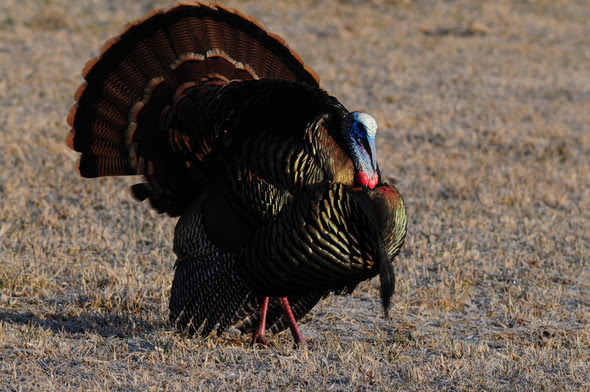
It’s the sound turkey hunters have been waiting for - wing tips dragging through dried grass and leaves - the Tom cautiously walks in out of view. His display begins – spitting and drumming, chest out, head back – in full strut, then all this gives way to the hair raising gobble that thunders through the timber. For spring turkey hunters the clock is ticking…. the season is a few weeks away. Photo courtesy of the Iowa DNR.
|
Enjoy those easy-to-see large flocks of turkeys feeding in the fields while you can. In the next few weeks, the winter flocks will break up, and where you saw them last weekend is not where they’ll be when spring turkey season opens in April.
Bagging a wild turkey is a challenge for even the most experienced hunters. Of the 50,000 licenses sold each spring, about 20 percent are placed on a bird.
“Turkeys have home field advantage. We go where they live and use calls that try to mimic the sounds of a hen. We are trying to reverse nature and get the Tom to come to the hen, which he knows is wrong. If you can frustrate the Tom enough that he ignores his instincts and goes looking for this fake hen, then as a hunter you have a chance,” said Jim Coffey Iowa DNR forest wildlife biologist. “Plus, they have excellent eyesight and hearing so not only do we have to sound realistic, we have to blend in with the landscape and stay motionless. That’s what makes turkey hunting such an intimate activity. Sounds easy.”
While heading home with and unfilled tag is common, what brings hunters back year after year is the experience of when the bird does come in.
The quiet spring morning is broken by the sound of a Toms’ wing tips dragging through dried leaves as he slowly walks in. He’s right behind you. His display begins – spitting and drumming, chest out, head back – in full strut, then all this gives way to the hair raising gobble that thunders through the timber. At this range, any movement will be noticed. Gotta stay calm and wait for the right moment.
The “dance” is what brings hunters back. And since predicting when the bird will come in is not possible, planning and preparing before the season arrives is an important step toward success.
Coffey said hunters should contact the landowner to make sure they still have access. They should also pattern their gun using the same choke and shot they will use during the season to know the gun and shot limitations.
“Nothing is more frustrating than shooting and missing at a turkey. We owe the bird the respect of only taking the best shot we can,” he said.
He also advises to start practicing calling so when the season begins hunters will be in midseason form.
“Scouting is also important and can greatly improve the chance of bagging a turkey,” Coffey said. “Spend some time in the timber or field you plan to hunt, identify roosting trees or which fields the birds are using, and look for activity signs like scratching, droppings or feathers.”
Iowa’s spring turkey gun/bow season begins with a youth season April 10-12, followed by four specific seasons. Season 1 is April 13-16, Season 2 is April 17-21, Season 3 is April 22-28 and Season 4 is April 29 to May 17. Hunters may purchase up to two spring turkey tags; one must be for fourth season. An archery only season is April 13-May 17.
Youth Season
An estimated 5,000 youth will participate in the Iowa April 10-12 spring turkey youth-only season. About one out of four of the youth will come home with a bird, which is a higher rate of success than during the regular spring turkey seasons.
“The youth season provides a wonderful mentored relationship much like learning how to drive where the parent helps them with the turning signals, brake pedals and keeping their excitement under control,” Coffey said. “Turkey hunting is an intimate experience done in close proximity between hunter and bird. It’s in that setting where the mentor will instruct and guide the youth on when to call, when to move or stay still. It’s passing on those woodsmanship skills learned over time.”
Hunters need to remember that any unfilled youth season tags will be valid until filled for the remaining spring seasons. The key is to make sure to purchase the youth tags before the youth season closes because once the season is over, that option is no longer available.
Reminder: Reporting Harvest is Mandatory
Successful hunters are required to report their harvest by midnight of the day after it is tagged. Be prepared to answer a few simple questions about your harvest, (county of harvest and spur length.) Hunters can report by going online to https://www.iowadnr.gov/Hunting/Report-Your-Harvest then clicking on the Harvest Report System button, by calling the phone number listed on the tag or by going through a license vendor. Be sure to write the harvest confirmation number on the harvest report tag. This allows the Iowa DNR to monitor annual harvest across the state.
Hunting Atlas Available Online
Hunters have a new tool that may improve their in the field experience even before opening day.
The Iowa hunting atlas is an interactive map that shows all available public hunting land that is managed by the state, county or federal governments. The atlas is online at www.iowadnr.gov/hunting. A mobile version is also available.
A click on an area will show basic information like size, habitat type and likely species available.
Media Contact: Jim Coffey, Forest Wildlife Research Biologist, Iowa Department of Natural Resources, 641-774-2958.